You never know what you'll like until you try it. Never say never.I prefer symmetrical too, on rivers. But on lakes, I don't really have a preference. Actually getting into something like a Trillium or Magic might change my mind.
-
Happy Dewey Decimal System Day! 📚🔢
You are using an out of date browser. It may not display this or other websites correctly.
You should upgrade or use an alternative browser.
You should upgrade or use an alternative browser.
Impact of Heeling - Canoe Design
- Thread starter NikonF5user
- Start date
You never know what you'll like until you try it. Never say never.
True. If I ever see a Magic or NW Solo in my price range within a day's drive, I'm all over that.
As far as asymmetrical rocker, for a solo boat or otherwise, I'm with Marc O and think I'll stick with symmetrical. I can't think of a reason not to.
I think one could make the argument that because of your normal stern heavy seating position that you actually do prefer asymmetrical rocker.
Alan
So, what about edging symmetrical (below the waterline) vs Swedeform? I still have to get the Moccasin and the Solitude out on the same day for comparison, but just going on memory it seems that the Solitude responds to edging for a turn a bit more than the Moccasin. Both 15.5' long. Both zero rocker. Both good secondary and easily edged. So Swedeform vs symmetrical is the only difference under the water.
Anyone else have an idea on that? I can't say I'm sure about it yet.
Anyone else have an idea on that? I can't say I'm sure about it yet.
For sure, even a slight change on trim or lean changes the boats performance.I think one could make the argument that because of your normal stern heavy seating position that you actually do prefer asymmetrical rocker.
Alan
This is something about which I know very little, but I believe you can have an asymmetrical boat that is not Swede-form; I have generally been under the impression that Swede-form boats have the widest part behind the enter, essentially making them longer in front of the beam and shorter behind. I believe this impacts the location of the center of rotation which would thus impact the rate of rotation and increases forward paddling efficiency because the entry-lines are sleeker. I believe a boat can have its widest point directly at midship and yet still be asymmetrical if the rocker is different fore and aft, which should have the impact of helping tracking (albeit without the benefit of the extra paddling efficiency awarded by the Swede-form hull), but I would think (especially with a solo) that an asymmetric boat with the widest point at midship would spin better when heeled than would a Swede-form boat when heeled.So, what about edging symmetrical (below the waterline) vs Swedeform? I still have to get the Moccasin and the Solitude out on the same day for comparison, but just going on memory it seems that the Solitude responds to edging for a turn a bit more than the Moccasin. Both 15.5' long. Both zero rocker. Both good secondary and easily edged. So Swedeform vs symmetrical is the only difference under the water.
Anyone else have an idea on that? I can't say I'm sure about it yet.
Again, I could be making all of this up, but it's how I have organized the thoughts in my head!
I'd say there are four types of hull symmetry or asymmetry.
1. Waterline (viewed from above AKA plan view). If the widest point of the waterline is forward of the longitudinal center of the hull, the hull is fishform. If the widest point it behind the center, the hull is swedeform.
2. Sheer line (side view of the gunwale line). A perfectly symmetrical sheer line would rise up from the longitudinal center to identical heights at the bow and stern stems. Many canoes that are otherwise symmetrical have higher bow than stern stems (for example, the Yost Fire canoes)
3. Gunwale line (plan view). Viewed from above, the gunwale lines may not be symmetrical. They would usually have the same asymmetry as the waterline, but not necessarily. Patrick Moore's Proem, for example, had a swedeform waterline but a fishform gunwale line, leading many to claim it was a fishform hull, which Moore denied because he felt the "fish" and "swede" terminology terms should relate to the waterline.
4. Rocker line. The rocker can be symmetrical or asymmetrical. This is what a lot of folks mean when they use those adjectives. Many touring canoes have less rocker in the stern than the bow; a few whitewater hulls have more rocker in the stern than the bow. It's possible to have an asymmetrical rocker line on a hull with a symmetrical waterline, or vice versa.
In addition, a hull viewed longitudinally (head on) can have flared sides, straight sides, tumblehomed sides, recessed gunwales, or shouldered gunwales.
How all these different combinations of symmetry/asymmetry and different hull shapes affect heeling is hard to generalize, other than at the extremes. That is, highly rockered canoes will be easier to turn than zero rocker canoes. Most touring canoes are not designed at these extremes, so it's hard to predict manueverability and tracking precisely just from specs. One's height, weight and gear load also affect heeled and unheeled performance.
This is why it's best to test paddle canoes . . . or . . . get 15 of them. A putter ain't a driver ain't a sand wedge.
1. Waterline (viewed from above AKA plan view). If the widest point of the waterline is forward of the longitudinal center of the hull, the hull is fishform. If the widest point it behind the center, the hull is swedeform.
2. Sheer line (side view of the gunwale line). A perfectly symmetrical sheer line would rise up from the longitudinal center to identical heights at the bow and stern stems. Many canoes that are otherwise symmetrical have higher bow than stern stems (for example, the Yost Fire canoes)
3. Gunwale line (plan view). Viewed from above, the gunwale lines may not be symmetrical. They would usually have the same asymmetry as the waterline, but not necessarily. Patrick Moore's Proem, for example, had a swedeform waterline but a fishform gunwale line, leading many to claim it was a fishform hull, which Moore denied because he felt the "fish" and "swede" terminology terms should relate to the waterline.
4. Rocker line. The rocker can be symmetrical or asymmetrical. This is what a lot of folks mean when they use those adjectives. Many touring canoes have less rocker in the stern than the bow; a few whitewater hulls have more rocker in the stern than the bow. It's possible to have an asymmetrical rocker line on a hull with a symmetrical waterline, or vice versa.
In addition, a hull viewed longitudinally (head on) can have flared sides, straight sides, tumblehomed sides, recessed gunwales, or shouldered gunwales.
How all these different combinations of symmetry/asymmetry and different hull shapes affect heeling is hard to generalize, other than at the extremes. That is, highly rockered canoes will be easier to turn than zero rocker canoes. Most touring canoes are not designed at these extremes, so it's hard to predict manueverability and tracking precisely just from specs. One's height, weight and gear load also affect heeled and unheeled performance.
This is why it's best to test paddle canoes . . . or . . . get 15 of them. A putter ain't a driver ain't a sand wedge.
I've heard Charlie Wilson many times declare that a heel to the offside presents a 'banana shape” of the hull to the water, thus partially countering the effect of turning away from the paddling side. I'm sure that depends on the amount of rocker as well as other hull shape factors.
In my new SR Blackwater, with its essentially zero rocker, after a summer paddling season of trials, it doesn’t seem to much care which way I single side paddle heel it to either continue on a straight line path, or to effect a reasonably tight turn. With some of my other solo canoes, when making a sharp carving turn, I can detect and hear when the stern "breaks lock" as I call it, as the stern slides around at the surface to greatly assist in pivoting me around the turn. Most of my canoes behave best going on a straight path with an offside heel. Again, I believe likely affected by rocker.
In my new SR Blackwater, with its essentially zero rocker, after a summer paddling season of trials, it doesn’t seem to much care which way I single side paddle heel it to either continue on a straight line path, or to effect a reasonably tight turn. With some of my other solo canoes, when making a sharp carving turn, I can detect and hear when the stern "breaks lock" as I call it, as the stern slides around at the surface to greatly assist in pivoting me around the turn. Most of my canoes behave best going on a straight path with an offside heel. Again, I believe likely affected by rocker.
- Joined
- Jun 22, 2017
- Messages
- 1,226
- Reaction score
- 1,448
I agree with this. I think it's hard to draw conclusions about one design variable in isolation (there's really no situation where "everything else is equal" except one thing). I think some design variables are coupled...so it's the combination that's key. I've paddled boats that heel beautifully at low speeds on calm water but get sticky and unresponsive at cruise speed or in current.How all these different combinations of symmetry/asymmetry and different hull shapes affect heeling is hard to generalize, other than at the extremes. That is, highly rockered canoes will be easier to turn than zero rocker canoes. Most touring canoes are not designed at these extremes, so it's hard to predict manueverability and tracking precisely just from specs. One's height, weight and gear load also affect heeled and unheeled performance.
That seems intuitive. And like I said, I'm going on memory - so that is suspect. I really need to get both boats on the lake on the same calm day. The "calm" thing has been rare around here lately.This is something about which I know very little, but I believe you can have an asymmetrical boat that is not Swede-form; I have generally been under the impression that Swede-form boats have the widest part behind the enter, essentially making them longer in front of the beam and shorter behind. I believe this impacts the location of the center of rotation which would thus impact the rate of rotation and increases forward paddling efficiency because the entry-lines are sleeker. I believe a boat can have its widest point directly at midship and yet still be asymmetrical if the rocker is different fore and aft, which should have the impact of helping tracking (albeit without the benefit of the extra paddling efficiency awarded by the Swede-form hull), but I would think (especially with a solo) that an asymmetric boat with the widest point at midship would spin better when heeled than would a Swede-form boat when heeled.
Again, I could be making all of this up, but it's how I have organized the thoughts in my head!
I agree with this. I think it's hard to draw conclusions about one design variable in isolation (there's really no situation where "everything else is equal" except one thing). I think some design variables are coupled...so it's the combination that's key. I've paddled boats that heel beautifully at low speeds on calm water but get sticky and unresponsive at cruise speed or in current.
I think we've narrowed all this down to "it depends".
I have both a composite (white gold) WildFire and RX Yellowstone Solo. Love them both.
Back in the day (2009) when P-net had lots of open boaters, the composite vs RX Wildfire debate was pretty common. At some point Charlie Wilson chimed in with the story of the development of the composite WildFire and RX (and later composite) Yellowstone Solo. You can still find it on P-com, but I saved it here:
 eckilson.blogspot.com
eckilson.blogspot.com
He confirms a lot of the differences that have already been discussed like the blunter ends, softer shoulders, asymmetrical rocker and swedeform shape of the RX Yellowstone Solo compared to the composite Wildfire. These differences are pretty apparent in this picture:
Having said that, for me personally, I don't find that the two boats paddle all that differently. For a freestyle paddler who is heeling the gunwales down to the water, I'm sure the composite WildFire with its sharper ends and more pronounced shoulders spins better than the RX Yellowstone Solo, but that is not how I paddle the boat. For river paddling, a bit of a lean and a little bit of current and either boat turns into or out of eddies just fine. On lakes, I don't find the tracking to be all that different. I'm on the heavy side (230 lbs), so maybe it is just that the boats are sitting low in the water anyway.
Back in the day (2009) when P-net had lots of open boaters, the composite vs RX Wildfire debate was pretty common. At some point Charlie Wilson chimed in with the story of the development of the composite WildFire and RX (and later composite) Yellowstone Solo. You can still find it on P-com, but I saved it here:
Bell WildFire vs. Yellowstone Solo
T he story of the development of the WildFire and Yellowstone Solo by Charlie Wilson from a 2009 post on P-net: "The Bell WildFire was conc...
He confirms a lot of the differences that have already been discussed like the blunter ends, softer shoulders, asymmetrical rocker and swedeform shape of the RX Yellowstone Solo compared to the composite Wildfire. These differences are pretty apparent in this picture:
Having said that, for me personally, I don't find that the two boats paddle all that differently. For a freestyle paddler who is heeling the gunwales down to the water, I'm sure the composite WildFire with its sharper ends and more pronounced shoulders spins better than the RX Yellowstone Solo, but that is not how I paddle the boat. For river paddling, a bit of a lean and a little bit of current and either boat turns into or out of eddies just fine. On lakes, I don't find the tracking to be all that different. I'm on the heavy side (230 lbs), so maybe it is just that the boats are sitting low in the water anyway.
Last edited:
Thanks, Erik. I had forgotten about that discussion and the mention of the Yellowstone being swedeform.
 I'm a welter weight, and while I don't have a Yellowstone to compare, I don't have any problem making the Wildfire track straight. But my previous boat was a MR Guide, so there's that.
I'm a welter weight, and while I don't have a Yellowstone to compare, I don't have any problem making the Wildfire track straight. But my previous boat was a MR Guide, so there's that.
...Or maybe it's just that you're on the right shoulder of that bell curve and your forward stroke doesn't suck.On lakes, I don't find the tracking to be all that different. I'm on the heavy side (230 lbs), so maybe it is just that the boats are sitting low in the water anyway.
Are those the only differences? I'm not familiar with either boat. Is the chine shape the same for both boats? If one has a harder/softer chine than the other, that will make a significant difference.So, what about edging symmetrical (below the waterline) vs Swedeform? I still have to get the Moccasin and the Solitude out on the same day for comparison, but just going on memory it seems that the Solitude responds to edging for a turn a bit more than the Moccasin. Both 15.5' long. Both zero rocker. Both good secondary and easily edged. So Swedeform vs symmetrical is the only difference under the water.
Anyone else have an idea on that? I can't say I'm sure about it yet.
Are those the only differences? I'm not familiar with either boat. Is the chine shape the same for both boats? If one has a harder/softer chine than the other, that will make a significant difference.
Good question. As soon as the sun comes up and sheds light on the lean-to, I'll take a closer look at both of them. Off the top of my head, I'm going to say the chines are probably different, but I can't describe from memory.
Yeah, they're quite different. I used a curve copying device to show it clearly. Both measurements are taken where I sit.
Notice in this photo, the guide is lined up close to the middle of the Solitude hull.
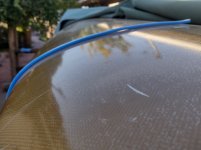
In this one, the end of the guide is a just a little past the center on the Moccasin. You can see that the bottom is both flatter and narrower.
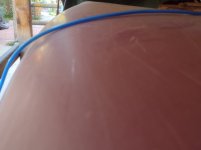
Both hulls viewed from near the stern.
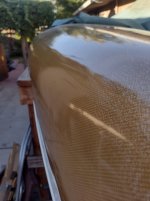
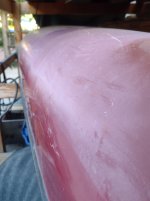
Here's another aid. You can really see a difference. I had to close that clamp in another half inch to get it to balance on the center of the Moccasin.
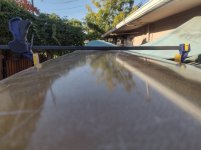
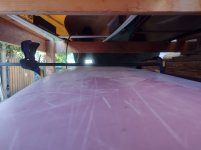
I think it's evident why the Solitude turns easier when edged than the Moccasin. It's wider and softer chined.
Notice in this photo, the guide is lined up close to the middle of the Solitude hull.

In this one, the end of the guide is a just a little past the center on the Moccasin. You can see that the bottom is both flatter and narrower.

Both hulls viewed from near the stern.


Here's another aid. You can really see a difference. I had to close that clamp in another half inch to get it to balance on the center of the Moccasin.


I think it's evident why the Solitude turns easier when edged than the Moccasin. It's wider and softer chined.
I'm not sure, but by using the term "edged", are you referring to heeling?
Yes. That's my ski jargon leaking in.I'm not sure, but by using the term "edged", are you referring to heeling?
Got it. Just wanted to be certain that we were talking about the same issue.Yes. That's my ski jargon leaking in.
So, looking back at my question about symmetrical vs swedeform - I guess I don't have an answer to that, since there are other differences in the hull shape between my two 15.5' solos. It's likely that the chine shape and width differences are just as much or more in play.
The only thing I can positively deduce from what I've experienced is that comparing different canoes and different methods of using them is fun.
The only thing I can positively deduce from what I've experienced is that comparing different canoes and different methods of using them is fun.
Similar threads
- Replies
- 4
- Views
- 5K
